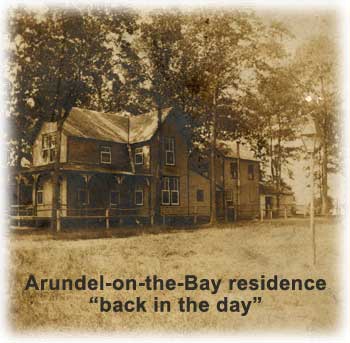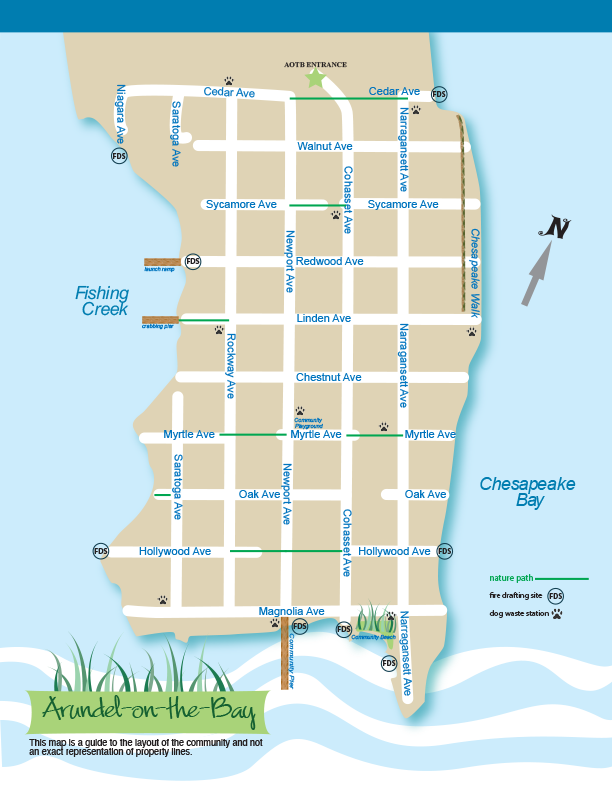ABOUT THE COMMUNITY OF ARUNDEL-ON-THE-BAY
~~~~~~~~~~
 Our history book is here!
Our history book is here!
The Amazing Story
of Arundel-on-the-Bay
1600s to Today
History
A bit of history from Richard (Marc) Grisby:
"I started coming to Arundel on the Bay with Dr. Hunt during the summer back in the mid 50's. My father moved here in 1969 and my wife in 1976. After each storm (snow or rain) I go through the community and clear the trees that are blocking the road and check on many of the elderly and house bound. Ed Lee, myself and one or two others have been doing that for about 40 years. We would open the roads up if it was snow, sometimes hooking two or three vehicles together to push and pull to get it done. If we did not do this, BG&E would not turn the power on and they would leave. They will only come back after the County has cut the trees and that could be two weeks. If the trees are already cut up when they get here, they will go to work to restore the power. That's the price you pay for living on Arundel on the Bay.
Living History |
"The Pier has reported that there was a land bridge from Arundel on the Bay to Thomas Point Light and that beach erosion washed it away: wrong. There has never been a land bridge to the Light House. I have the land plot from 1823 filed with the Maryland courts for ownership of Arundel on the Bay and it shows Thomas Point as an island and the original opening for Fishing Creek coming off the South River. Until 1853, Fishing Creek was a Lake. That year, a second small opening was formed from a storm, which is the opening that we have today.
"As a boy, we used to hang a lantern on a pole so that we could find our way back in here at night. Around 1978 the Coast Guard cut a channel into the creek, which resulted in what we have today. Power for the Light House comes from our point but that's about all. A side note: The first year the Redskins won the Super Bowl, that day the wind was blowing strong out of the north and at low tide all of the water was blown south. Several of us were able to walk almost to the day marker on dry/wet sand."
Marc Grigsby then casts doubt on testimony reported in past issues of The Pier here that a railroad once ran along the front of the property on Bay side. Appreciating Mr. Grigsby's comments, we conclude that the so-called land bridge to Thomas Point Light may indeed be a myth. There is some evidence, however, for the claim:
(1) A land connection is shown on the revised Plat for AotB prepared by the County Surveyor in May
1927 for the Meredith Lumber Company.
(2) On page 32 of Bay Ridge on the Chesapeake, by Jane Wilson McWilliams and Carol
Cushard Patterson (Annapolis: Brighton, 1986), there is a detail from a map of Anne Arundel County in
1860 by one Simon J. Martinet, placing the lighthouse on the southeast corner of the land girdling
Fishing Creek.
(3) An article by Mary P. Felter, entitled "Arundel-on-the-Bay Celebrates 100th Anniversary," in The
Capital of 7/20/1990, states: "At one time the community land used to go out to Thomas Point Lighthouse
before erosion affected the area."
(4) A map entitled "AOTP in 1906," appended to the June 12, 2007 report of the community's Long
Range Planning Committee, otherwise unidentified, shows an opening at the southwest corner of Fishing
Creek and a squiggly line running from the southeastern community point to the Light House.
Admittedly, this evidence is inconclusive. The Pier has asked for further documentation, if it's available,
through the County Library's reference service. So, when the Redskins won the Super Bowl, AOTB youth virtually walked on water.
Despite healthy skepticism, the Chesapeake and Columbia Street Railway does seem to
have existed, at least during the late 19th century:
(1) A photograph dated "circa 1891" on page 53 of the McWilliams-Patterson book clearly shows rail
tracks along the Bay shore looking across at Bay Ridge. The caption reads in part, "The resort viewed
from Arundel-on-the-Bay. . . . Tracks of the little private train that carried summer residents of Arundelon-
the-Bay to and from Bay Ridge can be seen in the foreground."
(2) Page 54 of the same work contains a paragraph describing "the Arundel-on-the-Bay Railroad (or
Chesapeake and Columbia Street Railway), consisting of one locomotive and four little red cars traveling
on a small single track extending three miles south through the fields and blackberry brambles along the
water's edge to a point just opposite Thomas Point Light in Arundel-on-the Bay. Completed on July 11,
1892, as the brainchild of Thomas W. Smith, the new summer colony's mayor, this 'blackberry train ' or
'the summer cars' carried residents of Arundel-on-the-Bay to card parties, dances, and evening
entertainments at Bay Ridge hotel. In spite of a schedule frequently disrupted by shifting sands and
summer squalls, the railroad was good-naturedly well patronized."
(3) On page 55 of that work, an 1894 plat of Highland Beach depicts " 'the summer cars' chugging to
Bay Ridge from Arundel-on-the-Bay and ready to cross the narrow entrance channel of Black Walnut
Creek." By the way, there is a station shown on that plat, suggesting that passengers boarded or left the
train at Highland Beach, raising an interesting question regarding the possibility that African Americans
might have used that train and may have been welcome at either end of the line, Jim Crow discrimination
notwithstanding.
(4) The Annapolis Evening Capital of July 14, 1892 carried the following note: "The summer car, with
its donkey engine, distance 3 miles [from Bay Ridge] to Arundel-on-the-Bay is well patronized. . . . The
run is delightful around the Bay Shore to opposite the Thomas Point Light." [Note that this last
observation suggests that Marc Grigsby was right about the absence of a land bridge to the Light.]
(5) The Felter article in The Capital of July 20, 1990: "Also once upon a time stage coaches and trains
made stops [at Arundel-on-the-Bay], and they used to have a post office and a hotel."
A hotel!!
Read a Feb. 3, 2008, story about Arundel-on-the-Bay in The Baltimore Sun
FLY ABOVE ARUNDEL ON THE BAY
Video Project
 Have you always wondered what Arundel-on-the-Bay was like "back in the day?" Philip Allen has begun an oral history project, filming some of our seniors who remember those days.
Have you always wondered what Arundel-on-the-Bay was like "back in the day?" Philip Allen has begun an oral history project, filming some of our seniors who remember those days.
The videos
were
produced by Philip Allen and David Hackett and filmed and edited by
Cassidy Falconetti. There are three so far.
The first video features William S. "Bill" Keyes. In his inimitable, fearless style, Bill Keyes discusses suvch subjects as social changes over a half-century of life in Arundel-on-the-Bay, the importance of education--especially to assure prospects for African-Americans, the continuity of the "Buffalo Soldier" tradition, "Negro League" baseball, and his wish for Peace and Harmony in our communitiy's future.
In the second video, Errol Brown narrates a walking tour around Arundel on the Bay. Watch and see who owns or once owned various houses and learn a lot about the history of this area too.
In the third videom Mrs. Rachel Brown and her son, Errol Brown, reminisce about the history of Arundel on the Bay, back in the day, in an entertaining discussion about the many professional African-Americans who bought in the neighborhood in the early 1950s. The discussion touches on how racial discrimination affected residence and educational patterns in the area.
Click on the camera to see the videos.
New Resident Information - coming soon
Photo Gallery
Directions
From Bay Ridge Road in Annapolis, turn right onto Arundel-on-the-Bay Road. Turn left as Arundel-on-the-Bay Road turns left, at the Oyster Harbor community sign. The entrance to the community is about 1/2 mile ahead. The community is accessible from the Chesapeake Bay via Fishing Creek, just north of Thomas Point LIghthouse and the South River. See NOAA chart 12270.

